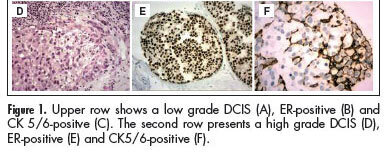Revista Brasileira de Ginecologia e Obstetrícia. 2013;35(3):97-102

PURPOSE:To compare the prognostic and predictive features between in situ and invasive components of ductal breast carcinomas. METHODS:We selected 146 consecutive breast samples with ductal carcinoma in situ (DCIS) associated with adjacent invasive breast carcinoma (IBC). We evaluated nuclear grade and immunohistochemical expression of estrogen receptor (ER), progesterone receptor (PR), human epidermal growth factor receptor 2 (HER2), cytokeratin 5/6 (CK5/6), and epidermal growth factor receptor (EGFR) in both components, in situ and invasive, and the Ki-67 percentage of cells in the invasive part. The DCIS and IBC were classified in molecular surrogate types determined by the immunohistochemical profile as luminal (RE/PR-positive/ HER2-negative), triple-positive (RE/RP/HER2-positive), HER2-enriched (ER/PR-negative/HER2-positive), and triple-negative (RE/RP/HER2-negative). Discrimination between luminal A and luminal B was not performed due to statistical purposes. Correlations between the categories in the two groups were made using the Spearman correlation method. RESULTS:There was a significant correlation between nuclear grade (p<0.0001), expression of RE/RP (p<0.0001), overexpression of HER2 (p<0.0001), expression of EGFR (p<0.0001), and molecular profile (p<0.0001) between components in situ and IBC. CK 5/6 showed different distribution in DCIS and IBC, presenting a significant association with the triple-negative phenotype in IBC, but a negative association among DCIS. CONCLUSIONS: Our results suggest that classical prognostic and predictive features of IBC are already determined in the preinvasive stage of the disease. However the role of CK5/6 in invasive carcinoma may be different from the precursor lesions.
Search
Search in:


Comments